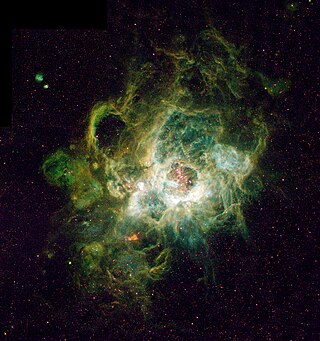List of largest nebulae
From Wikipedia, the free encyclopedia
Below is a list of the largest known nebulae so far discovered, ordered by actual diameter. This list is prone to change because of inconsistencies between studies, the great distances of nebulae from our stellar neighborhood, and the constant refinement of technology and engineering.
This article has multiple issues. Please help improve it or discuss these issues on the talk page. (Learn how and when to remove these messages)
|

Caveats
Nebulae have no standardized boundaries, so the measurements are subject to revision. Furthermore, scientists are still defining the features and parameters of nebulae. Because of these rapid developments and adjustments, this list may be unreliable.
Lyman alpha nebulae around quasars can have sizes between 15 kpc and 460 kpc.[1] Especially large Enormous Lyα nebula (ELAN) can have large sizes of ≳100 kpc.[2] Farina et al. 2019 table 5 has an extensive compilation of Lyman alpha nebulae around quasars.[1] For now this list contains only the largest ELANs, with sizes larger than 300 kpc.
List
| Image | Nebula | Maximum dimension (in light-years/parsecs) |
Type | Notes |
|---|---|---|---|---|
| Abell 3391/3395 ICM[3] | 49,000,000 ly (15,000,000 pc)[3] | Intracluster medium (ICM) | Continuous warm-hot emission filament between two galaxy clusters. | |
| Abell 1659S ICM[4] | 2,413,000 ly (740,000 pc)[4] | Intracluster medium (ICM) | One of the gas clumps of the Abell 1659 galaxy cluster. | |
| Abell 1659N ICM[4] | 1,618,000 ly (496,000 pc)[4] | Intracluster medium (ICM) | One of the gas clumps of the Abell 1659 galaxy cluster. | |
 |
Slug Nebula[5] | 1,500,000 ly (460,000 pc)[6] | Enormous Lyα nebula (ELAN) | Around the quasar UM287 at around z=2.3. Cosmic filament illuminated by the quasar. |
| MAMMOTH-1 | 1,441,000 ly (442,000 pc)[7] | Enormous Lyα nebula (ELAN) | The nebula is associated with the galaxy overdensity BOSS1441,[7] which is a protocluster at z=2.3. The nebula represents the circumgalactic medium. Its emission is powered by starburst and an obscured AGN. One of the most extended ELAN discovered as of 2019.[8] | |
 |
NGC 262 Halo Cloud | 1,300,000 ly (400,000 pc)[9] | H I region | Spiral nebula surrounding NGC 262, which is one of the largest known galaxies. |
 |
Ivory Nebula | 1,190,500 ly (365,000 pc)[2] | Enormous Lyα nebula (ELAN) | Also called MLAN1 at z=2.31. Another ELAN, called MLAN 10 is nearby. |
 |
Q0042−2627 nebula | 1,040,000 ly (320,000 pc)[10] | Enormous Lyα nebula (ELAN) | Around the quasar LBQS 0042-2627, at z=3.280 |
| Jackpot Nebula[11] | 1,010,000 ly (310,000 pc)[12] | Enormous Lyα nebula (ELAN) | Four quasars embedded in the nebula. Likely progenitor of a massive galaxy cluster at z=2.05. | |
 |
Fabulous Nebula[13] | 969,000 ly (297,000 pc)[14] | Enormous Lyα nebula (ELAN) | Also called SDSS J1020+1040 nebula, after the central quasar (aka 4C 10.29), located at z=3.164. Inspiraling material.[14] Will likely evolve into an elliptical galaxy.[13] |
 |
Leo Ring | 650,000 ly (200,000 pc)[15] | HVC | A large ring of cold gas that formed from a collision of two galaxies.[16] |
 |
Magellanic Stream | 600,000 ly (180,000 pc)[17] | complex of HVCs | Connects the Large and Small Magellanic clouds; extends across 180° of the sky. |
 |
filament near TXS 0206-048 | 391,000 ly (120,000 pc)[18] | [O II] nebula | Longest cool filament near a quasar as of 2022. Quasar is located at z=1.13. Filament is accreted into the galaxy and subsequently to the quasar. |
 |
EELR of 3C 458 | 363,000 ly (111,000 pc)[19] | emission line nebula | The size is likely larger. The paper only describes the maximal distance to the nucleus and not the entire size. |
 |
nebula around the Teacup galaxy | 363,000 ly (111,000 pc)[20] | ionized nebula | part of the circumgalactic medium around the Teacup galaxy, illuminated by the AGN |
 |
Lyman-alpha blob 1 | 300,000 ly (92,000 pc)[21] | LαB | Largest blob in the LAB Giant Concentration[citation needed] |
 |
Himiko Gas Cloud | 55,000 ly (17,000 pc)[22] | Intergalactic cloud (possible LαB) |
One of the most massive lyman-alpha blobs known |
| HVC 127-41-330 | 20,000 ly (6,100 pc)[23] | HVC | ||
 |
Smith's Cloud | 9,800 ly (3,000 pc)[24] | HVC | Extends about 20° of the sky |
 |
Tarantula Nebula | 1,895 ly (581 pc)[25][a] | H II region | Most active starburst region in the Local Group |
 |
NGC 604 | 1,520 ly (470 pc)[26][27][b] | H II region | Largest H II region located in the Triangulum Galaxy |
 |
N44 | 1,000 ly (310 pc)[28] | Emission nebula | Contains a 250 light year wide superbubble that was probably formed from stellar winds.[29] |
 |
N11 | 1,000 ly (310 pc)[30] | H II region | N11 is the second largest star formation region in the Large Magellanic Cloud galaxy. |
 |
NGC 2404 | 940 ly (290 pc) | H II region | Largest H II region located in the spiral galaxy NGC 2403 |
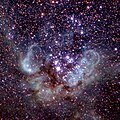 |
NGC 595 | 880 ly (270 pc)[31] | H II region | Contains massive stars that have strong stellar winds. |
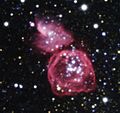 |
Ring Nebula (NGC 6822) | 838 ly (257 pc) | H II region | The Ring Nebula is located in the lower right of the image |
 |
Gum Nebula | 809–950 ly (248–291 pc)[32][33] | Emission nebula | Extends about 36° of the sky |
 |
Bubble Nebula (NGC 6822) | 758 ly (232 pc)[34][35][36] | H II region | The Bubble Nebula is located in the upper left of the image |
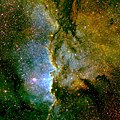 |
NGC 6188 | 600 ly (180 pc)[37] | Emission nebula | |
 |
NGC 592 | 580 ly (180 pc)[38][39] | H II region | Located in the Triangulum Galaxy |
 |
Sh2-310 | 531–681 ly (163–209 pc)[40][c] | H II region | Nebula surrounding VY Canis Majoris, which is one of largest known stars. |
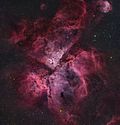 |
Carina Nebula | 460 ly (140 pc)[41] | H II region | Nearest giant H II region to Earth |
 |
Dragonfish Nebula | 450 ly (140 pc)[42] | Emission nebula | |
 |
N119 | 430–570 ly (131–175 pc)[43] | H II region | Peculiar S-shape |
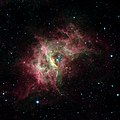 |
RCW 49 | 350 ly (110 pc)[44] | H II region | |
 |
Soul Nebula | 330 ly (100 pc)[45] | H II region | |
 |
Heart Nebula | 330 ly (100 pc)[46] | H II region | Has been named the “Heart nebula” because of its resemblance to a human heart. |
 |
Henize 70 (N70 or DEM L301)[47] | 300 ly (92 pc)[48] | H II region | The N 70 Nebula, in the Large Magellanic Cloud has a shell structure and is really a bubble in space. It is a "Super Bubble". |
 |
Barnard's Loop | 300 ly (92 pc)[49][50] | H II region | Supernova over the last 4 million years probably carved cavities in gas clouds forming the semi circle shape of Barnard’s loop. |
 |
Sh2-54 | 252 ly (77 pc)[51][52] | H II region | |
 |
Prawn Nebula | 250 ly (77 pc)[53] | H II region | |
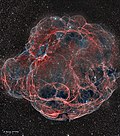 |
Simeis 147 | 160 ly (49 pc)[54] | Supernova remnant | |
 |
NGC 7822 | 150 ly (46 pc)[55] | Emission nebula | |
 |
IC 2944 | 142 ly (44 pc)[56][57] | Emission nebula | |
 |
Eagle Nebula | 140 ly (43 pc)[58] | H II region | Part of another diffuse nebula IC 4703. |
 |
Rosette Nebula | 130 ly (40 pc)[59] | H II region | Only 36 stars were known to be in this nebula but the Chandra telescope increased the number of known stars to 160. |
 |
Lagoon Nebula | 110 ly (34 pc)[60] | H II region | |
| Veil Nebula | 100–130 ly (31–40 pc)[61] | Supernova remnant | Located in the Cygnus Loop | |
 |
NGC 3576 | 100 ly (31 pc)[62] | Emission nebula | |
 |
N41 | 100 ly (31 pc)[63] | Emission nebula | |
| The following well-known nebulae are listed for the purpose of comparison. | ||||
 |
Orion Nebula | 20 ly (6.132 pc)[64] | Diffuse Nebula | The closest major star formation region to Earth.[65] |
 |
Crab Nebula | 11 ly (3.4 pc)[66] | Supernova remnant | The remnant of a supernova that occurred in 1054 AD.[67] |
 |
Bubble Nebula | 6[68]-10[69][70] ly (1.84-3.066 pc) | Emission nebula | |
 |
Helix Nebula | 5.74 ly (1.76 pc)[71] | Emission nebula | |
 |
Eightburst Nebula | 0.8 ly (0.2453 pc)[72] | Emission nebula | |
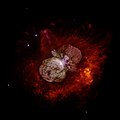 |
Homunculus Nebula | 0.58 ly (0.1778 pc) [73] | Emission nebula | Surrounds the star system Eta Carinae. |
 |
Stingray Nebula | 0.16 ly (0.049 pc)[74] | Emission nebula | One of the smallest nebulae. |
See also
Notes
- Those measurements are based on an apparent diameter of 480 arcminutes (') plus an assumed distance of 1.5 kpc and the current distance of VY CMa which is about 1.17 kpc as the nebula is sometimes found to have the same distance as VY CMa.
References
Sources
Wikiwand - on
Seamless Wikipedia browsing. On steroids.
